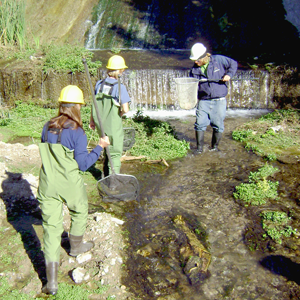SAWA
RCRCD is a member of SAWA, the Santa Ana Watershed Association. SAWA is a non-profit organization that works to restore native habitat in the Santa Ana Water Rivershed.

SAWA removes invasive plants and animals from waterways and, when necessary, replants native species that do not naturally reestablish. With SAWA, the RCRCD conducts ongoing invasive plant monitoring and/or removal projects at Alessandro Arroyo, Fairmount Park Wilderness Area, La Sierra Creek, Mockingbird Canyon, Temescal Canyon, the mainstem of the Santa Ana River, and at the River Road Bridge.
By the end of 2008, SAWA removed and treated more than 3,200 acres of invasive plants, restoring native riparian forest to broad areas in the River and its tributaries. As a result, over 11,250 acre-feet of water are restored to the river each year (native plants use less water than invasive, exotic plants).
Efforts to protect the endangered Least Bell’s Vireo and the Willow Flycatcher, small migratory songbirds that nest along the River, include habitat restoration and nest management. SAWA field biologists monitor habitat sites and remove the invasive Brown-headed Cowbird.
The Brown-headed Cowbird is a brood parasite. Rather than build its own nest, it lays its eggs in the nests of other birds. The songbirds continue to incubate the Cowbirds’ eggs along with their own. Cowbird chicks grow quickly and out-compete the songbird hatchlings. Most often, songbird chicks do not survive and the adult vireos or flycatchers spend their time raising Cowbird chicks. When biologists check nests, they remove the Cowbird eggs, so the adult songbirds are able to raise their own chicks.
In 1980, 300 Least Bell's Vireo pairs had been identified in California, of which only 19 pairs had been found in the Santa Ana River watershed. As a result of local restoration efforts, over 1,000 vireo territories were identified in the watershed during 2009.
Lear more about SAWA, local wildlife, and more at www.sawatershed.org.
